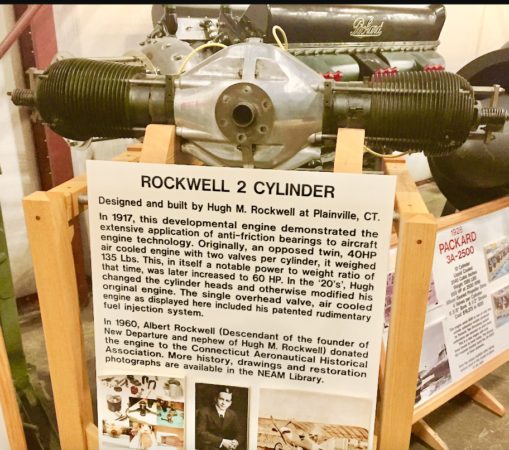Innovation, Invention, Aviation, Aerospace: At New England Air Museum
Inspiration. In a world that never stops moving toward the future, now becomes then. Across time, the way things connect can be surprising.
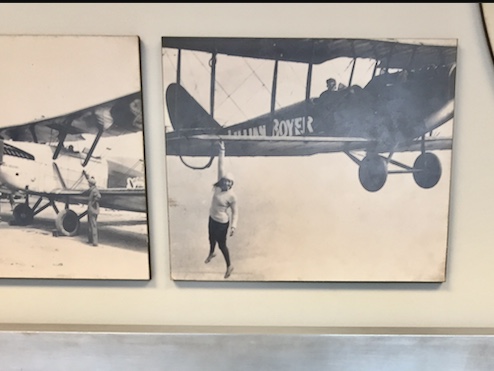
Four fingers and a thumb, from an aircraft in flight – and she made it look effortless as a photographer caught this image – from the 1920 barnstormers section of the NEAM aviation timeline.
Take, for instance, an engine seen at the New England Air Museum (NEAM) in Windsor Locks, Connecticut. It was a gift (1960) of Albert Rockwell, a descendant of the founder of New Departure (ND) Manufacturing Company in Bristol, CT, and nephew of Hugh M. Rockwell.
From the informational signage: “This engine was designed and built by Hugh M. Rockwell in Plainville, CT. In 1917, this developmental engine demonstrated the extensive application of anti-friction bearings to aircraft engine technology. It is an opposed twin, 40 hp, air-cooled engine with two valves per cylinder and weighed 135 lbs. giving it a very favorable power-to-weigh ratio. In the 1920s the cylinder headers were changed along with some other modifications. The engine on display is a single overhead valve which included Rockwell's patented rudimentary fuel injection system.” Having toured the former ND facility in Meriden (story linked here), there was delight in learning more about the founder and this mechanical innovation (with mention of the anti-friction bearings) that was accomplished in 1917.
Each object can be a touchstone, a gateway for a story or stories about human ingenuity, persistence, engineering, achievements, adventure, business. Connections. Stories unlock context, purpose, the intersection where past, present and future intermingle. New journeys of science, technology, engineering, mathematics – STEM – await, the potential to launch endeavors inspired by those who have gone before and shown what can be achieved.
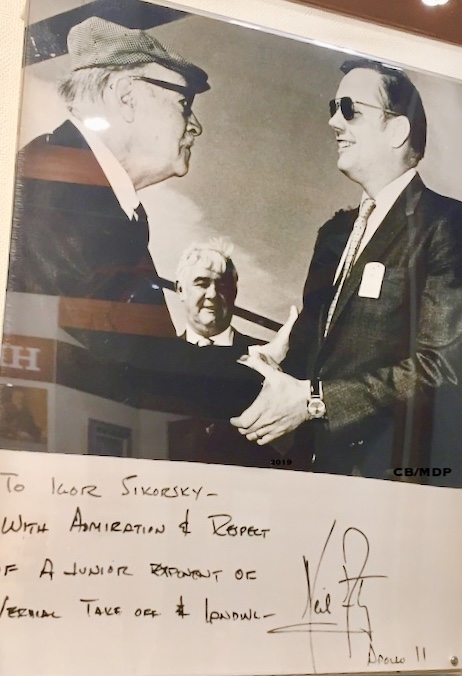
“Two pioneers greet each other, Igor Sikorsky and astronaut Neil Armstrong; one saw the dawn of air travel; the other the dawn of space travel.”
Caption of image at New England Air Museum, Sikorsky section.
Still thinking about the details of the crew's life inside a U.S. Navy blimp control car, anti-submarine coastal patrol, because of of the insight and shared knowledge provided by Tom Stevenson, NEAM docent (and USAF veteran). The access walkway for the airship's control car – literally a metal plank that the crew could lower to work on an engine in flight? Unforgettable.
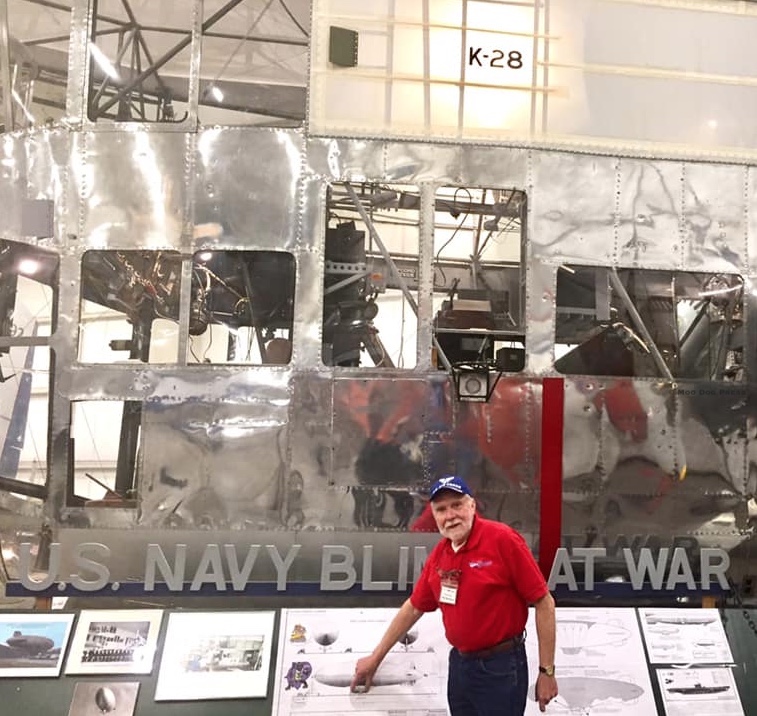
“You have to see this” he said – and Tom Stevenson, shown here with the Goodyear ZNPK-28 Blimp Control Car, was correct.
Notable is the dedicated work of so many behind the scenes performing the meticulous work of restoration. The K-28 also stands as a legacy and memorial to the work of the late Russ Magnuson, who passed at the age of 90 in November 2018. An Army veteran who served in Korea as a field radio repairman, he worked for the New Britain Machine company for 35 years and upon retirement, became a docent at the museum. “Recognizing the desire to restore the Goodyear K-Ship, Magnuson spent 23 years meticulously restoring the blimp car back to its original WW II configuration.” – NEAM news page.
For provoking wonder and new ideas, physical objects can prompt questions. How does it work? Who made it happen? Why does it matter? Stand next to a Sikorsky CH-54B ‘Tarhe' (S-64B ‘Skycrane') to get a feel for the sheer size and power of this machine. Consider how mechanics got to the top for maintenance.
The location on Perimeter Road and proximity to Bradley International Airport and the Connecticut Air National Guard 103rd Airlift Wing (third-oldest ANG unit in the U.S.) – plus the Connecticut Fire Academy and air traffic control tower for Bradley – make NEAM an unforgettable and absorbing destination. Be forewarned that a visit with children is a completely different experience than a solo expedition for immersion in knowledge contained here. Schools and Scouts visit regularly; upcoming events include Women Take Flight in March 2019.
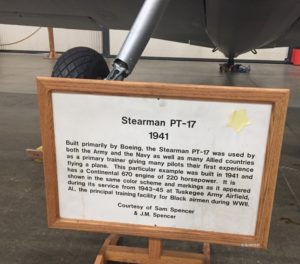
Stearman PT-17 1941. “Built primarily by Boeing…used by both the Army and the Navy as well as many Allied countries as a primary trainer…It is shown in the same color scheme and markings as it appeared during its service from 1943-45 at Tuskegee Army Airfield, Alabama, the principal training facility for black airmen during World War II.
The aircraft, innovators, risk-takers, pioneers, inventors and everyday people called to act in world wars fill acres of indoor space in a place that celebrates the human passion for flight. For those who cannot visit in person, there are “virtual” 360-degree panorama views are available – including views of the restoration shop. Stated mission here is a commitment to “presenting the story of aviation, the human genius that made it possible and the profound effects that it has had on the way in which we live.”
A hallway features an aviation timeline, faces and machines, notables. Early use of aircraft, mail delivery. The photography reproduced and on display throughout the museum is noteworthy in and of itself.
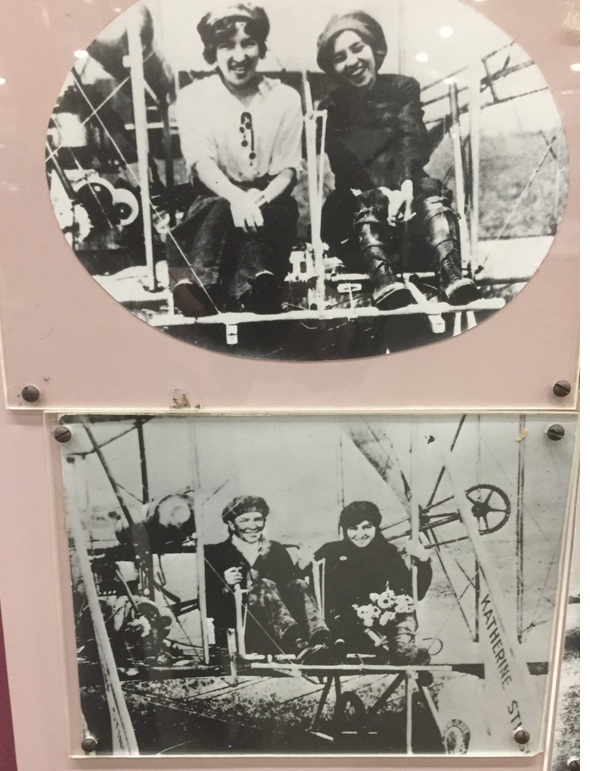
Delivering the mail. Imagine what these pilots experienced in flight with this aircraft. “The flying sisters, Katherine and Marjorie Stinson, each flew official air mail. Katherine was sworn in as the first U.S. woman air mail carrier 9/26/1913 and flew the air mail every day at the Montana State Fair…”
There's a row of computers as flight simulators, along with the right-now technology interface that is Flightradar24, a “global flight tracking service that provides you with real-time information about thousands of aircraft around the world. Flightradar24 tracks 180,000-plus flights, from 1,200-plus airlines, flying to/or from 4,000 plus airports around the world in real time.” Located near the main hangar entrance, just past where tickets are purchased (and a bookstore/gift shop) to the New England Air Museum, is a flat screen display for visitors, but the app is also available for handheld computing devices – iPhone, iPad, Apple Watch, Android. Quite amazing the data aggregated and available – here is a link to how it works. For those interested, take the time to peruse the commercial services page and businesses that use this data service. Stevenson pointed out how each aircraft in motion on a screen yields details with just a click. Detailed flight information for each aircraft is revealed in layers, along with weather and arrival/departures for airports.
From a dream to first flight; then endless modifications and designs, trial and error, each moving an industry forward – and just think. It's only been a short span of time from fabric-and-wooden craft to jet power and then on to reach the moon, science harnessed in new ways to gather information in air and space but also adapted for ocean explorations.
It's only been decades since watching F-4s taxi, power up, take off – sometimes, straight up; C-130s doing touch and goes on an active flightline. The unmistakeable signature sound of a Sikorsky HH-53H, inbound. Now to see an F-4 inside as a static exhibit is a reminder of constant change and adaptations taking place.
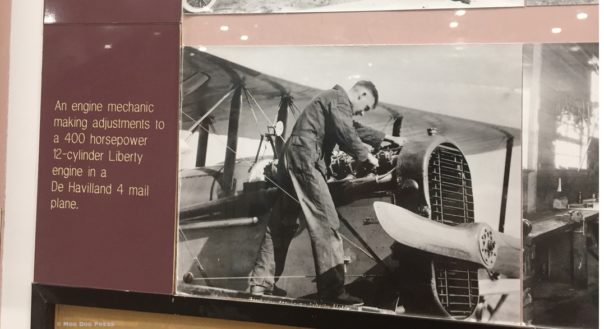
An engine mechanic making adjustments to a 400-horsepower 12-cylinder Liberty engine in a De Havilland 4, mail plane – caption from the exhibit hall/timeline section at NEAM.
Editor's note: With so much to see and learn, let's not forget the ground crew, mechanics, makers, machinists, pilots, ground crew – all those whose skills are at work behind each aircraft, airship, aerospace expedition. Some early aviators, inventors, sketches, imaging technologies. Coming up in part two.

